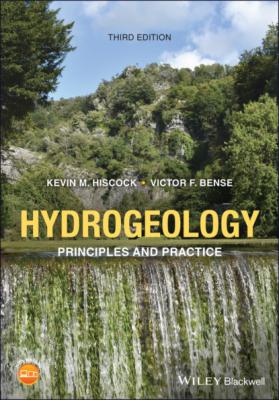ТОП просматриваемых книг сайта:
Hydrogeology. Kevin M. Hiscock
Читать онлайн.Название Hydrogeology
Год выпуска 0
isbn 9781119569510
Автор произведения Kevin M. Hiscock
Жанр Биология
Издательство John Wiley & Sons Limited
Fig. 1.8 The hydrological cycle. The global water cycle has three major pathways: precipitation, evaporation and water vapour transport. Vapour transport from sea to land is returned as runoff (surface water and groundwater flow). Numbers in ( ) represent inventories (in 106 km3) for each reservoir. Fluxes in [ ] are in 106 km3 a−1 (Berner and Berner 1987).
(Source: Berner, E.K. and Berner, R.A. (1987) The Global Water Cycle: Geochemistry and Environment. Prentice‐Hall, Inc., Englewood Cliffs, New Jersey. © 1987, Pearson Education.)
Within the water cycle, and in order to conserve total water, evaporation must balance precipitation for the Earth as a whole. The average global precipitation rate, which is equal to the evaporation rate, is 496 000 km3 a−1. However, as Fig. 1.8 shows, for any one portion of the Earth, evaporation and precipitation generally do not balance. The differences comprise water transported from the oceans to the continents as atmospheric water vapour and water returned to the oceans as river runoff and a small amount (∼6%) of direct groundwater discharge to the oceans (Zektser and Loaiciga 1993).
Table 1.1 Inventory of water at or near the Earth's surface (Berner and Berner 1987).
(Source: Berner, E.K. and Berner, R.A. (1987) The Global Water Cycle: Geochemistry and Environment. Prentice‐Hall, Inc., Englewood Cliffs, New Jersey. © 1987, Pearson Education.)
| Reservoir | Volume (×106 km3) | Percentage of total |
|---|---|---|
| Oceans | 1370 | 97.25 |
| Ice caps and glaciers | 29 | 2.05 |
| Deep groundwater (750–4000 m) | 5.3 | 0.38 |
| Shallow groundwater (<750 m) | 4.2 | 0.30 |
| Lakes | 0.125 | 0.01 |
| Soil moisture | 0.065 | 0.005 |
| Atmospherea | 0.013 | 0.001 |
| Rivers | 0.0017 | 0.0001 |
| Biosphere | 0.0006 | 0.00004 |
| Total | 1408.7 | 100 |
Note:
a As liquid equivalent of water vapour.
Fig. 1.9 The distribution of water at or near the Earth's surface. Only a very small amount of freshwater (<0.3% of total water) is readily available to humans and other biota (Maurits la Rivière 1989).
(Source: Maurits la Rivière, J.W. (1989) Threats to the world’s water. Scientific American 261, 48–55.)
The interfaces between hydrological compartments in the water cycle have important implications for water quantity and quality. Processes at the interfaces between the hydrological compartments (for example, soil‐atmosphere or soil‐groundwater) determine the age distribution of the water fluxes between these compartments and can, thus, greatly influence water travel and residence times (Sprenger et al. 2019). The age distribution of water spans over a wide range of temporal scales. In the ‘critical zone’, the Earth's boundary layer ranging from the top of the vegetation layer to the bottom of the groundwater storage, water ages range from hours to millennia (Fig. 1.10).
By taking the constant volume of water in a given reservoir and dividing by the rate of addition (or loss) of water to (from) it enables the calculation of a residence time for that reservoir. For the oceans, the volume of water present (1370 × 106 km3; see Fig. 1.8) divided by the rate of river runoff to the oceans (0.037 × 106 km3 a−1) gives an average time that a water molecule spends in the ocean of about 37 000 years. Lakes, rivers, glaciers and shallow groundwater have residence times ranging between days and thousands of years. Because of extreme variability in volumes and precipitation and evaporation rates, no simple average residence time can be given for each of these reservoirs. As a rough calculation, and with reference to Fig. 1.8 and Table 1.1, if about 6% (2220 km3 a−1) of runoff from land is taken as active groundwater circulation, then the time taken to replenish the volume (4.2 × 106 km3) of shallow groundwater stored below the Earth's surface is of the order of 2000 years. In reality, groundwater residence times vary from about 2 weeks to 10 000 years (Nace 1971), and longer (Edmunds 2001). A similar estimation for rivers provides a value of about 20 days. These estimates, although a gross simplification of the natural variability, do serve to emphasize the potential longevity of groundwater pollution compared to more rapid flushing of contaminants from river systems.
1.5.1 Groundwater occurrence in the upper continental crust
Focusing on the upper 2 km of the continental crust in which most hydrogeological observations are made, Gleeson et al. (2015) combined multiple approaches using geospatial datasets, tritium age dating of groundwater and numerical modelling to show that less than 6% of the groundwater in the uppermost portion of the Earth's land mass is less than 50 years old, representing modern groundwater that is the most recently recharged. Gleeson et al. (2015) found that the total groundwater volume in the upper 2 km of continental crust is approximately 22.6 × 106 km3, of which 0.1–5.0 × 106 km3 is less than 50 years old. The distribution of this modern groundwater is spatially heterogeneous, with very little in arid regions. Although modern groundwater represents a small percentage of the total groundwater storage on Earth, the volume of this component is still very significant, equivalent to a water depth of about 3 m spread over the world's continents.
1.5.2 Groundwater‐related tipping points
Several potential groundwater‐related tipping points are associated with the storage function of groundwater (Gleeson et al. 2020). Most critical for aquatic ecosystems is the role of groundwater as a stable supply of baseflow, and therefore a key tipping point is when a stream transitions from perennial to intermittent

